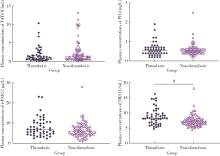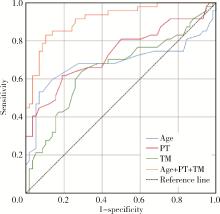Journal of Peking University (Health Sciences) ›› 2023, Vol. 55 ›› Issue (6): 1033-1038. doi: 10.19723/j.issn.1671-167X.2023.06.012
Previous Articles Next Articles
Predictive value of four items of new thrombus markers combined with conventional coagulation tests for thrombosis in antiphospholipid syndrome
Li-rong HONG1,2,Yu-jia CHEN2,Qing-lai JIANG2,Ru-lin JIA1,*( ),Chun LI1,Liang-hua FENG2,*(
),Chun LI1,Liang-hua FENG2,*( )
)
- 1. Department of Rheumatology and immunology, Peking University People's Hospital, Beijing 100044, China
2. Xiamen Fifth Hospital Rheumatology Department, Xiamen 361101, Fujian, China
CLC Number:
- R593.2
| 1 |
Miyakis S , Lockshin MD , Atsumi T , et al. International consensus statement on an update of the classification criteria for definite antiphospholipid syndrome (APS)[J]. J Thromb Haemost, 2006, 4 (2): 295- 306.
doi: 10.1111/j.1538-7836.2006.01753.x |
| 2 |
Galli M , Luciani D , Bertolini G , et al. Anti-β2-glycoprotein Ⅰ, antiprothrombin antibodies, and the risk of thrombosis in the antiphospholipid syndrome[J]. Blood, 2003, 102 (8): 2717- 2723.
doi: 10.1182/blood-2002-11-3334 |
| 3 |
Cervera R , Serrano R , Pons-Estel GJ , et al. Morbidity and mortality in the antiphospholipid syndrome during a 10-year period: A multicentre prospective study of 1 000 patients[J]. Ann Rheum Dis, 2015, 74 (6): 1011- 1018.
doi: 10.1136/annrheumdis-2013-204838 |
| 4 | 徐文龙, 沙宇. 血栓分子标志物联合Caprini评分预测创伤性下肢骨折后深静脉血栓形成风险研究[J]. 中国卫生检验杂志, 2023, 33 (2): 245-248, 257. |
| 5 | Zhao X , Yang S , Lei R , et al. Clinical study on the feasibility of new thrombus markers in predicting massive cerebral infarction[J]. Front Neurol, 2022, 13, 942887. |
| 6 |
Tonello M , Mattia E , Favaro M , et al. IgG phosphatidylserine/prothrombin antibodies as a risk factor of thrombosis in antiphospholipid antibody carriers[J]. Thromb Res, 2019, 177, 157- 160.
doi: 10.1016/j.thromres.2019.03.006 |
| 7 |
Schaller J , Gerber SS . The plasmin-antiplasmin system: structural and functional aspects[J]. Cell Mol Life Sci, 2011, 68 (5): 785- 801.
doi: 10.1007/s00018-010-0566-5 |
| 8 |
Salet DM , Bekkering S , Middeldorp S , et al. Targeting thromboinflammation in antiphospholipid syndrome[J]. J Thromb Haemost, 2023, 21 (4): 744- 757.
doi: 10.1016/j.jtha.2022.12.002 |
| 9 | Zhou K , Zhang J , Zheng ZR , et al. Diagnostic and prognostic value of TAT, PIC, TM, and t-PAIC in malignant tumor patients with venous thrombosis[J]. Clin Appl Thromb Hemost, 2020, 26, 1- 10. |
| 10 |
Wang L , Zhong J , Xiao D , et al. Thrombomodulin (TM), thrombin-antithrombin complex (TAT), plasmin-α2-plasmininhibitor complex (PIC), and tissue plasminogen activator-inhibitor complex (t-PAIC) assessment of fibrinolytic activity in postpartum hemorrhage: A retrospective comparative cohort study[J]. Ann Transl Med, 2022, 10 (23): 1273.
doi: 10.21037/atm-22-5221 |
| 11 |
Loghmani H , Conway EM . Exploring traditional and nontraditional roles for thrombomodulin[J]. Blood, 2018, 132 (2): 148- 158.
doi: 10.1182/blood-2017-12-768994 |
| 12 | Pletsch-Borba L , Grafetstatter M , Husing A , et al. Vascular injury biomarkers and stroke risk: A population-based study[J]. Neurology, 2020, 94 (22): e2337- e2345. |
| 13 |
Kamtchum-Tatuene J , Mwangalika Kachingwe G , Mwandumba HC , et al. Endothelial dysfunction and carotid atherosclerosis in Malawian adults: A cross-sectional study[J]. eNeurologicalSci, 2020, 20, 100252.
doi: 10.1016/j.ensci.2020.100252 |
| 14 | Gosselin RC . An acute need inspiration: Autoneutralization of lupus anticoagulants in affected prothrombin times (PT) and activated partial thromboplastin times (APTT)[J]. Methods Mol Biol, 2023, 2663, 289- 295. |
| 15 | Fei Y , Tang N , Zhang H , et al. Significantly prolonged prothrombin time and activated partial thromboplastin time with no bleeding tendency: A patient with lupus anticoagulant-hypoprothrombinemia syndrome positive for immunoglobulin M anti-phosphatidylserine/prothrombin complex antibodies[J]. Semin Thromb Hemost, 2020, 46 (4): 507- 511. |
| 16 | Erzen B , Sabovic M . In young post-myocardial infarction male patients elevated plasminogen activator inhibitor-1 correlates with insulin resistance and endothelial dysfunction[J]. Heart Vessels, 2013, 28 (5): 570- 577. |
| 17 | Nordenhem A , Leander K , Hallqvist J , et al. The complex between tPA and PAI-1: Risk factor for myocardial infarction as studied in the SHEEP project[J]. Thromb Res, 2005, 116 (3): 223- 232. |
| 18 | Winter MP , Kleber ME , Koller L , et al. Prognostic significance of tPA/PAI-1 complex in patients with heart failure and preserved ejection fraction[J]. Thromb Haemost, 2017, 117 (3): 471- 478. |
| 19 | Lundbech M , Krag AE , Christensen TD , et al. Thrombin generation, thrombin-antithrombin complex, and prothrombin fragment F1+2 as biomarkers for hypercoagulability in cancer patients[J]. Thromb Res, 2020, 186, 80- 85. |
| 20 | Tao J , Guo X , Li D , et al. Increased level of thrombomodulin is associated with endothelial injury in patients with sepsis-induced disseminated intravascular coagulation[J]. Clin Lab, 2021, 67 (8): 1863- 1870. |
| 21 | Asanuma K , Nakamura T , Okamoto T , et al. Do coagulation or fibrinolysis reflect the disease condition in patients with soft tissue sarcoma[J]. BMC cancer, 2022, 22 (1): 1075. |
| 22 | Guo X , Tao H , Li D , et al. The α2-plasmin inhibitor-plasmin complex is a potential biomarker of venous thromboembolism in orthopedic trauma patients[J]. Clin Lab, 2021, 67 (4): 1065- 1072. |
| [1] | Yu-ke HOU,Qing-meng CAI,Xiang-jun LIU,Ze-lin YUN,Chun LI,Xue-wu ZHANG. Clinical significance of oxidized low-density lipoprotein antibody in antiphospholipid syndrome [J]. Journal of Peking University (Health Sciences), 2022, 54(6): 1117-1122. |
| [2] | Yu-hua WANG,Guo-hua ZHANG,Ling-ling ZHANG,Jun-li LUO,Lan GAO. Adrenal hemorrhage in a patient with systemic lupus erythematosus [J]. Journal of Peking University(Health Sciences), 2019, 51(6): 1178-1181. |
| [3] | Jie-yu GU,Cui LU,Hui SHI,Cheng-de YANG. Case series and clinical analysis of 14 cases of catastrophic antiphospholipid syndrome [J]. Journal of Peking University(Health Sciences), 2018, 50(6): 1033-1038. |
| [4] | Ji LI,Li ZHENG,Lian-jie SHI,Jing XU,Jian-long SHU,Xue-wu ZHANG. Increased serum soluble-endoglin level and its clinical significance in antiphospholipid syndrome [J]. Journal of Peking University(Health Sciences), 2018, 50(6): 1027-1032. |
| [5] | ZHENG Xiao-Juan, DENG Xiao-Li, LIU Xiang-Yuan. Pregnancy outcome in 54 patients with antiphospholipid syndrome:a retrospective clinical study [J]. Journal of Peking University(Health Sciences), 2014, 46(2): 323-328. |
|
||



